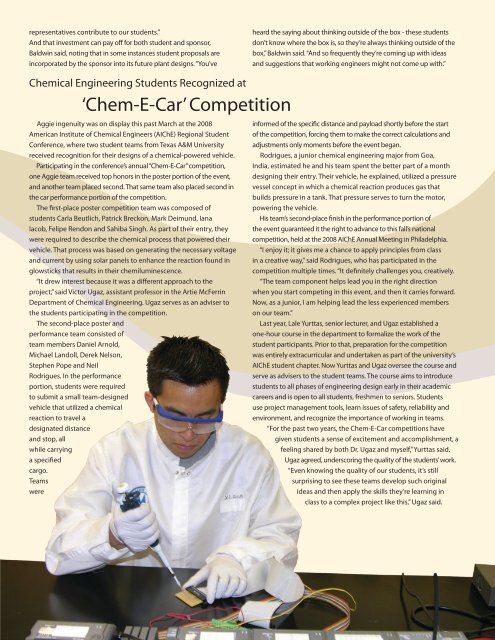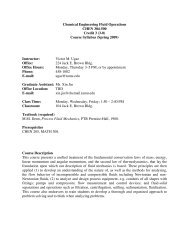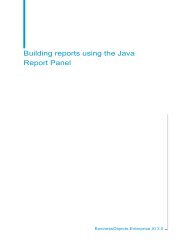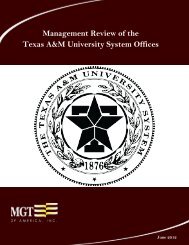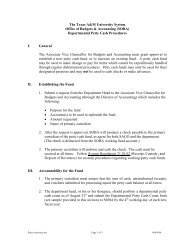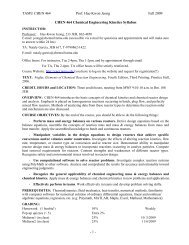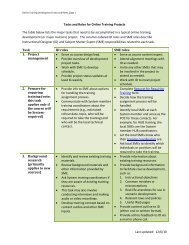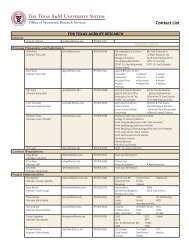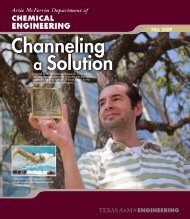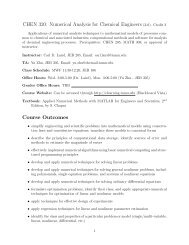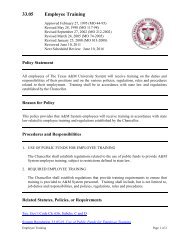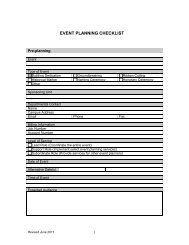STUDENT ACHIEVEMENTS<strong>Department</strong> Recognizes Fall 2007 Graduating ClassThe Artie McFerrin <strong>Department</strong> <strong>of</strong> <strong>Chemical</strong> <strong>Engineering</strong>’s 42 fallgraduates were honored this past December with a reception andawards ceremony in which aselect group <strong>of</strong> outstandingchemical engineeringstudents was recognized.Kristen Gantt, a senior fromAnchorage, Alaska, receivedthe department’s “OutstandingGraduating Senior Fall 2007Award.” Kendra Gil, a seniorfrom Colorado Springs,Colo., received the “<strong>Chemical</strong>Kristen Gantt receives the OutstandingSenior Award.<strong>Engineering</strong> Excellence Fall2007 Senior Award.” AndKiri Kilpatrick, a senior from Carrollton, <strong>Texas</strong>, received the “2007Senior Award” from the RHO Chapter <strong>of</strong> Omega Chi Epsilon,the national honor society for chemical engineering. In addition,Anthony Skach, a senior from Angleton, <strong>Texas</strong>, received his polymerspecialization certification.Addressing the students and their families in attendance, UnocalPr<strong>of</strong>essor and <strong>Department</strong> Head Michael Pishko encouraged thesoon-to-be graduates to stay in touch, reminding them <strong>of</strong> howimportant former students are to the department. “Even thoughyou’re leaving, you’re still a part <strong>of</strong> this department, and we wantto know <strong>of</strong> your triumphs,” Pishko said. Senior Lecturer and Headfor Lower Division Programs John Baldwin, who served as master<strong>of</strong> ceremonies for the event, congratulated the group, saying, “We’regoing to miss you because all <strong>of</strong> us fall in love with all <strong>of</strong> you.You’re the reason we’re here.”Fall 2007 Plant Design Competition Brings out Best in StudentsFor the better part <strong>of</strong> a semester, <strong>Texas</strong> A&M University chemicalengineering students in John Baldwin’s senior-level plant designcourse prepared for the pr<strong>of</strong>essional environment they would soonbe encountering by undertaking a real-world assignment. Theircharge was anything but simple: design a fully functional chemicalprocessing plant for the CelaneseCorporation, a global leader in thechemical manufacturing industry.This past December those studentsunveiled their final designs, and a selectfew received some very real-worldrecognition for their efforts, thanksin part to Celanese, the sponsor andjudge <strong>of</strong> the fall semester “plant designcompetition” - part <strong>of</strong> a capstonecourse in the university’s Artie McFerringas. It’s a task, Baldwin said, that graduates <strong>of</strong> the department arealmost certain to encounter in some form when they enter theirpr<strong>of</strong>essional careers. <strong>Chemical</strong> engineers, Baldwin said, <strong>of</strong>ten playthe role <strong>of</strong> conceptual designers who are typically charged withdesigning entire sequences <strong>of</strong> operations associated with chemicalmanufacturing. Those operations caninclude such processes as distillation,boiling, condensation and othervarious and complex aspects <strong>of</strong> plantproduction. “That’s what it’s all about -to move our students from an academicenvironment to a pr<strong>of</strong>essional engineeringenvironment,” Baldwin said.“Before these students come intoplant design, they are real engineers;they don’t know it. And what you see<strong>Department</strong> <strong>of</strong> <strong>Chemical</strong> <strong>Engineering</strong>.here is the discovery <strong>of</strong> ‘Gee, I can doFirst-place team (left to right): Kristen Gantt, Ryan Deal, CelaneseRyan Deal, Kristen Gantt, Sean Hulseythis!’ You see the light bulbs going on.representative Nathan Powell, Jared Morgan and Sean Hulseyand Jared Morgan were members <strong>of</strong> theThis puts together the project <strong>of</strong> a typicalstudent team awarded first place by Celanese for its original designs <strong>of</strong> engineering environment here in an academic institution.” Divideda methanol-producing industrial plant.into eight teams, each consisting <strong>of</strong> four to five members, Baldwin’sWest and Associates, composed <strong>of</strong> Kyle Gentry, Galen Hauth,students first waded through a 12-page problem statement,Richard Schultheis and Brittaney West was awarded second place, extensively detailing the scenario and the requested outcomes byand S.M.O.W., composed <strong>of</strong> Jesus Mejorada, Matt Olson, Anthony the Celanese Corporation, which uses methanol as a starting pointSkach and Aaron Wilhelm, received third-place honors. Eachfor a number <strong>of</strong> its acetic acid products. The students then spent<strong>of</strong> the winning teams received a monetary prize from Celanese,the semester researching - and in some instances even visiting -and the first-place team also was recognized with a plaquesimilar existing plants. They also picked the brains <strong>of</strong> Celanesecommemorating its achievement. The competition, explained<strong>of</strong>ficials, who made themselves available throughout the project.Baldwin, a senior lecturer and head for lower division programs“The main thing they do is contribute their time and energy toin the department, required students to conceptualize thethe project,” said Baldwin, lauding the corporation’s dedicationcomprehensive organization <strong>of</strong> a process plant - in this scenario, a to the competition and its students. “The monetary awards thatmethanol-producing plant that derives its product from synthetic are given are not nearly as valuable as the time that the companyPage 6
epresentatives contribute to our students.”And that investment can pay <strong>of</strong>f for both student and sponsor,Baldwin said, noting that in some instances student proposals areincorporated by the sponsor into its future plant designs. “You’veheard the saying about thinking outside <strong>of</strong> the box - these studentsdon’t know where the box is, so they’re always thinking outside <strong>of</strong> thebox,” Baldwin said. “And so frequently they’re coming up with ideasand suggestions that working engineers might not come up with.”<strong>Chemical</strong> <strong>Engineering</strong> Students Recognized at‘Chem-E-Car’ CompetitionAggie ingenuity was on display this past March at the 2008American Institute <strong>of</strong> <strong>Chemical</strong> Engineers (AIChE) Regional StudentConference, where two student teams from <strong>Texas</strong> A&M Universityreceived recognition for their designs <strong>of</strong> a chemical-powered vehicle.Participating in the conference’s annual “Chem-E-Car” competition,one Aggie team received top honors in the poster portion <strong>of</strong> the event,and another team placed second. That same team also placed second inthe car performance portion <strong>of</strong> the competition.The first-place poster competition team was composed <strong>of</strong>students Carla Beutlich, Patrick Breckon, Mark Deimund, IanaIacob, Felipe Rendon and Sahiba Singh. As part <strong>of</strong> their entry, theywere required to describe the chemical process that powered theirvehicle. That process was based on generating the necessary voltageand current by using solar panels to enhance the reaction found inglowsticks that results in their chemiluminescence.“It drew interest because it was a different approach to theproject,” said Victor Ugaz, assistant pr<strong>of</strong>essor in the Artie McFerrin<strong>Department</strong> <strong>of</strong> <strong>Chemical</strong> <strong>Engineering</strong>. Ugaz serves as an adviser tothe students participating in the competition.The second-place poster andperformance team consisted <strong>of</strong>team members Daniel Arnold,Michael Landoll, Derek Nelson,Stephen Pope and NeilRodrigues. In the performanceportion, students were requiredto submit a small team-designedvehicle that utilized a chemicalreaction to travel adesignated distanceand stop, allwhile carryinga specifiedcargo.Teamswereinformed <strong>of</strong> the specific distance and payload shortly before the start<strong>of</strong> the competition, forcing them to make the correct calculations andadjustments only moments before the event began.Rodrigues, a junior chemical engineering major from Goa,India, estimated he and his team spent the better part <strong>of</strong> a monthdesigning their entry. Their vehicle, he explained, utilized a pressurevessel concept in which a chemical reaction produces gas thatbuilds pressure in a tank. That pressure serves to turn the motor,powering the vehicle.His team’s second-place finish in the performance portion <strong>of</strong>the event guaranteed it the right to advance to this fall’s nationalcompetition, held at the 2008 AIChE Annual Meeting in Philadelphia.“I enjoy it; it gives me a chance to apply principles from classin a creative way,” said Rodrigues, who has participated in thecompetition multiple times. “It definitely challenges you, creatively.“The team component helps lead you in the right directionwhen you start competing in this event, and then it carries forward.Now, as a junior, I am helping lead the less experienced memberson our team.”Last year, Lale Yurttas, senior lecturer, and Ugaz established aone-hour course in the department to formalize the work <strong>of</strong> thestudent participants. Prior to that, preparation for the competitionwas entirely extracurricular and undertaken as part <strong>of</strong> the university’sAIChE student chapter. Now Yurttas and Ugaz oversee the course andserve as advisers to the student teams. The course aims to introducestudents to all phases <strong>of</strong> engineering design early in their academiccareers and is open to all students, freshmen to seniors. Studentsuse project management tools, learn issues <strong>of</strong> safety, reliability andenvironment, and recognize the importance <strong>of</strong> working in teams.“For the past two years, the Chem-E-Car competitions havegiven students a sense <strong>of</strong> excitement and accomplishment, afeeling shared by both Dr. Ugaz and myself,” Yurttas said.Ugaz agreed, underscoring the quality <strong>of</strong> the students’ work.“Even knowing the quality <strong>of</strong> our students, it’s stillsurprising to see these teams develop such originalideas and then apply the skills they’re learning inclass to a complex project like this,” Ugaz said.


